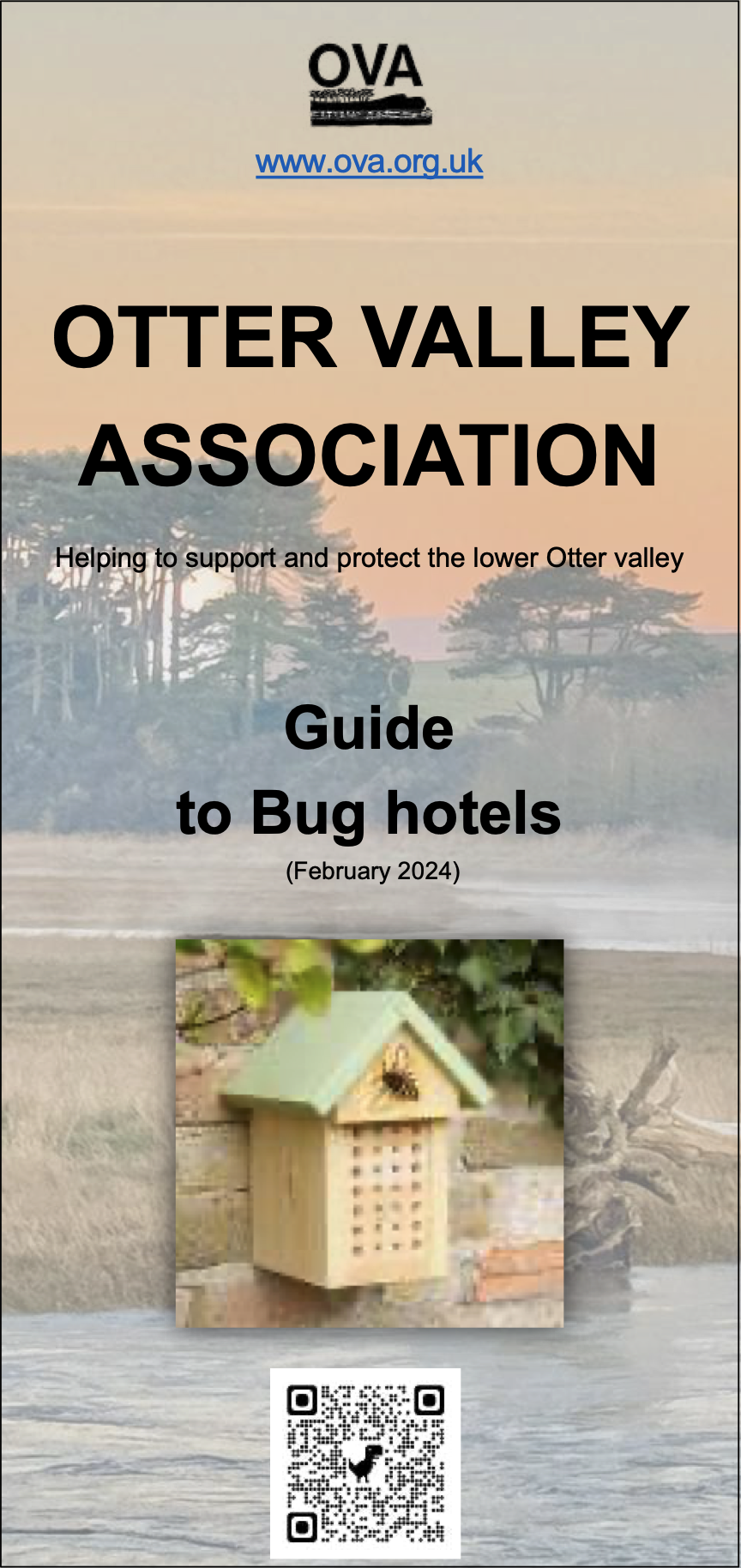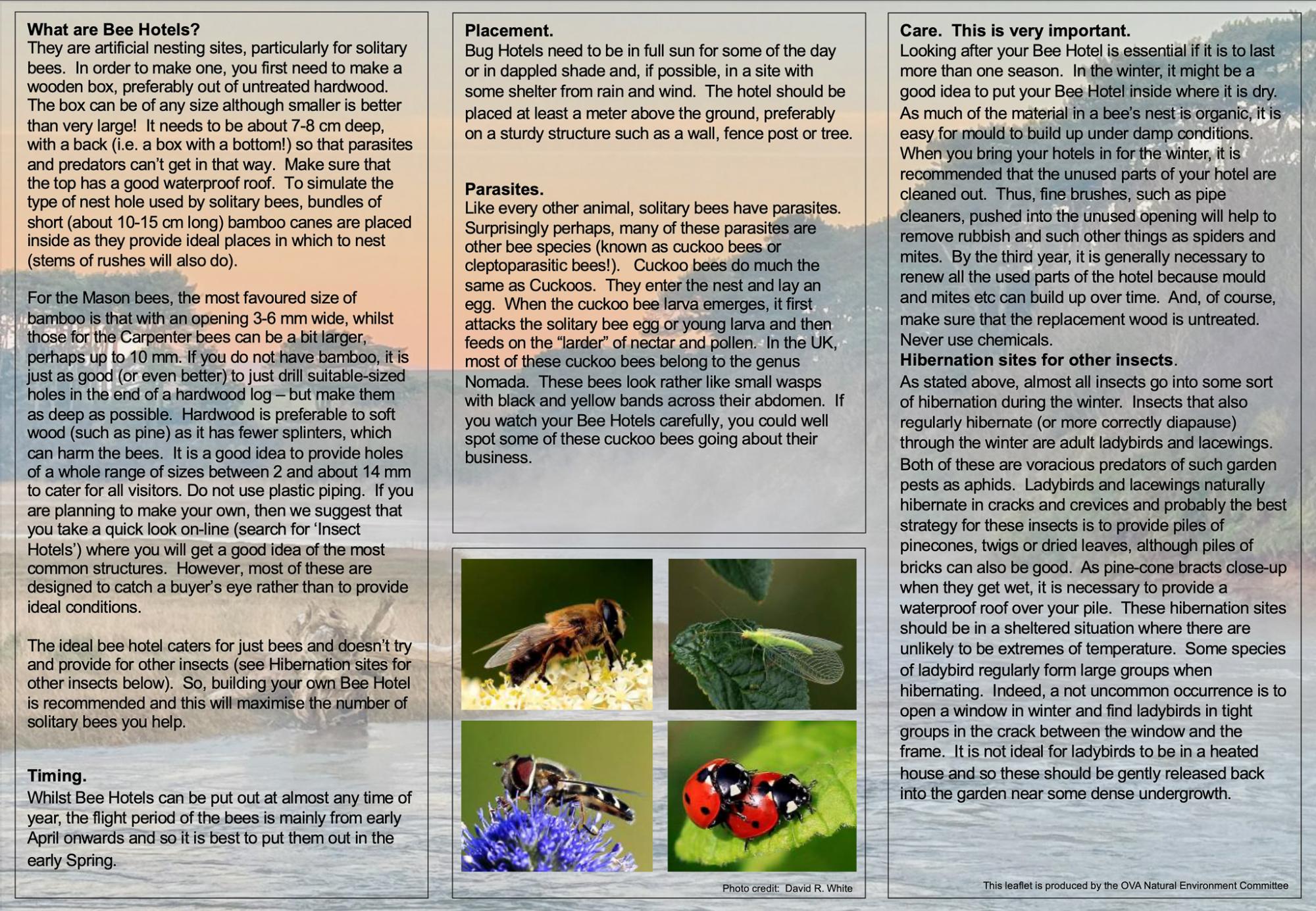Sadly, like so much of our wildlife, bee populations are becoming much reduced and any help can only do good. The purpose of Bee Hotels is primarily to provide safe places for certain insects (such as bees) to breed and to overwinter, particularly for those insects that are beneficial in the garden. We hope you enjoy the material provided. If you would like to download and print a one-page leaflet about bug hotels, please do click on one of the images shown here:
 |  |
Almost all insects go into hibernation over the cold winter months. Many overwinter as adults (such as ladybirds) whilst others overwinter as an egg or in an immature stage (as larvae or pupae - such as many bees and butterflies). Suitable sites are becoming fewer and harder to find as man “tidies up” the countryside. So, Bee Hotels are there to help. Bee Hotels are primarily for Solitary Bees (see below), but it is also fairly easy to help other insects such as ladybirds and lacewings. These hotels can vary from just a bundle of short lengths of bamboo to larger structures.
About bees
Apart from honeybees and bumble bees, the other bees that are important pollinators in the wild are referred to as Solitary Bees. There are some 29 different genera of solitary bees and about 240 species in the UK. Solitary bees do not have a hive and live more or less solitary lives (although many form loose colonies). They make their nests individually in tunnels in soft soil, wood or stems, crumbling mortar or in holes made by other insects and most feed their larvae on pollen and nectar. Only two genera of solitary bees regularly use Bee Hotels in the UK. Leaf-cutter bees (Megachile sp.) which, as their name suggests, cut half-moons out of leaves (particularly roses!) and use them to line the nest. These bees are about 8-10 mm long and will use holes up to perhaps 12+ mm wide. Tunnels made by Carpenter Bees are easily identified because the entrance is sealed with leaves.
The other type of bee that commonly uses Bee Hotels are Mason bees (Osmia sp.) and they are smaller (6-8 mm long) and use narrower tunnels, 4-6 mm wide. These bees usually plug their nests with mud or similar types of material. They fly from early March but are most often seen in late May or June. There are also many smaller bees (which can look rather like flies) which also use tunnel nests and their entrances can be down to 2 mm. You could experiment and see whether any of your small holes are used.
Carpenter and Mason Bees have a similar life cycle. When a suitable tunnel is made (or found), they build 6-8 chambers in each and line them with either leaves or mud. When each chamber has had a suitable amount of nectar and pollen added (as food for the larva), an egg is laid, and another chamber is built on top. Those chambers near the base of the nest generally contain female eggs and the eggs near the entrance generally produce males. The bees overwinter as pupae in their chambers and emerge in the Spring – the males first so that they are around to fertilise the emerging females.
Solitary bees and wasps are harmless and can be approached quite safely – so you can stand by your Bee Hotels and watch the activity at quite close quarters.
Final comment
If you do not get your Bee Hotel until late Spring and do not manage to put it out until June, you may not expect to see much activity. However, if you provide a good home, you may still be lucky to find solitary bees building nests within a matter of days and mud plugs appearing in the bamboos, so your Bee Hotel may be utilised very quickly! Good luck and enjoy!
What are Bee Hotels?
They are artificial nesting sites, particularly for solitary bees. In order to make one, you first need to make a wooden box, preferably out of untreated hardwood. The box can be of any size although smaller is better than very large! It needs to be about 7-8 cm deep, with a back (i.e. a box with a bottom!) so that parasites and predators can’t get in that way. Make sure that the top has a good waterproof roof. To simulate the type of nest hole used by solitary bees, bundles of short (about 10-15 cm long) bamboo canes are placed inside as they provide ideal places in which to nest (stems of rushes will also do).
For the Mason bees, the most favoured size of bamboo is that with an opening 3-6 mm wide, whilst those for the Carpenter bees can be a bit larger, perhaps up to 10 mm. If you do not have bamboo, it is just as good (or even better) to just drill suitable-sized holes in the end of a hardwood log – but make them as deep as possible. Hardwood is preferable to soft wood (such as pine) as it has fewer splinters, which can harm the bees. It is a good idea to provide holes of a whole range of sizes between 2 and about 14 mm to cater for all visitors. Do not use plastic piping. If you are planning to make your own, then we suggest that you take a quick look on-line (search for ‘Insect Hotels’) where you will get a good idea of the most common structures. However, most of these are designed to catch a buyer’s eye rather than to provide ideal conditions.
The ideal bee hotel caters for just bees and doesn’t try and provide for other insects (see Hibernation sites for other insects below). So, building your own Bee Hotel is recommended and this will maximise the number of solitary bees you help.
Timing
Whilst Bee Hotels can be put out at almost any time of year, the flight period of the bees is mainly from early April onwards and so it is best to put them out in the early Spring.
Placement
Bug Hotels need to be in full sun for some of the day or in dappled shade and, if possible, in a site with some shelter from rain and wind. The hotel should be placed at least a meter above the ground, preferably on a sturdy structure such as a wall, fence post or tree.
Parasites
Like every other animal, solitary bees have parasites. Surprisingly perhaps, many of these parasites are other bee species (known as cuckoo bees or cleptoparasitic bees!). Cuckoo bees do much the same as Cuckoos. They enter the nest and lay an egg. When the cuckoo bee larva emerges, it first attacks the solitary bee egg or young larva and then feeds on the “larder” of nectar and pollen. In the UK, most of these cuckoo bees belong to the genus Nomada. These bees look rather like small wasps with black and yellow bands across their abdomen. If you watch your Bee Hotels carefully, you could well spot some of these cuckoo bees going about their business.
Care
This is very important. Looking after your Bee Hotel is essential if it is to last more than one season. In the winter, it might be a good idea to put your Bee Hotel inside where it is dry. As much of the material in a bee’s nest is organic, it is easy for mould to build up under damp conditions. When you bring your hotels in for the winter, it is recommended that the unused parts of your hotel are cleaned out. Thus, fine brushes, such as pipe cleaners, pushed into the unused opening will help to remove rubbish and such other things as spiders and mites. By the third year, it is generally necessary to renew all the used parts of the hotel because mould and mites etc can build up over time. And, of course, make sure that the replacement wood is untreated. Never use chemicals.
Hibernation sites for other insects
As stated above, almost all insects go into some sort of hibernation during the winter. Insects that also regularly hibernate (or more correctly diapause) through the winter are adult ladybirds and lacewings. Both of these are voracious predators of such garden pests as aphids. Ladybirds and lacewings naturally hibernate in cracks and crevices and probably the best strategy for these insects is to provide piles of pinecones, twigs or dried leaves, although piles of bricks can also be good. As pine-cone bracts close-up when they get wet, it is necessary to provide a waterproof roof over your pile. These hibernation sites should be in a sheltered situation where there are unlikely to be extremes of temperature. Some species of ladybird regularly form large groups when hibernating. Indeed, a not uncommon occurrence is to open a window in winter and find ladybirds in tight groups in the crack between the window and the frame. It is not ideal for ladybirds to be in a heated house and so these should be gently released back into the garden near some dense undergrowth.
